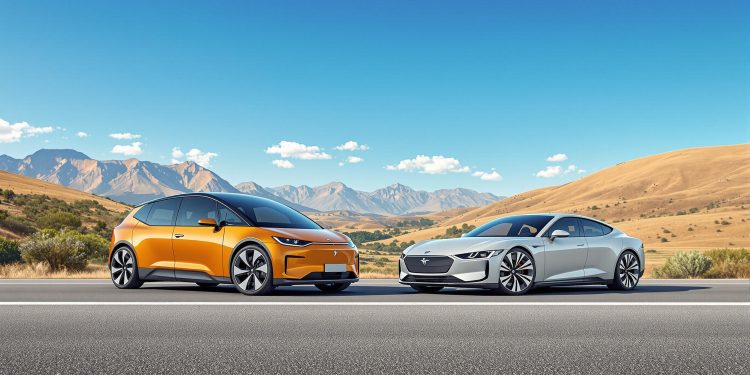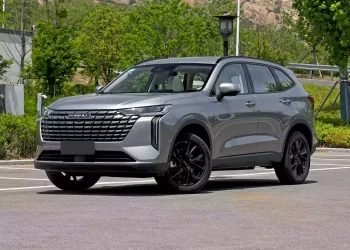Electric cars are gaining momentum in South Africa, but challenges remain. Here’s what you need to know:
- Sales Growth: Electric vehicle (EV) sales rose 85.4% in 2023, reaching 931 units, while hybrid vehicles led the market with 6,484 units sold.
- Cost Differences: EVs are still expensive, starting at $27,500 (R500,000), compared to $13,500 (R246,000) for petrol cars. However, EVs cost 30-50% less to run.
- Infrastructure Issues: South Africa has 316 public charging stations, but load-shedding and limited coverage make EV adoption difficult.
- Environmental Impact: With 90% of electricity from coal, EVs in South Africa currently produce more CO2 than petrol cars.
Quick Comparison
| Criteria | Electric Vehicles (EVs) | Petrol Vehicles |
|---|---|---|
| Starting Price | $27,500 (R500,000) | $13,500 (R246,000) |
| Running Costs | 30-50% cheaper per mile | Higher due to fuel prices |
| Market Share (2023) | 0.17% (931 units sold) | Dominates the market |
| Carbon Emissions | Higher due to coal-powered electricity | Lower in South Africa’s context |
| Infrastructure | 316 charging stations, mostly urban areas | Widespread petrol stations nationwide |
Despite the growth, South Africa’s EV market faces hurdles like high costs, limited infrastructure, and environmental concerns tied to coal-based electricity. Fixing these issues will be key to wider EV adoption.
Electric Cars In South Africa 2024 | Cost of Ownership …
Current Market Status
In South Africa, petrol-powered vehicles still dominate the automotive market, but electric vehicles (EVs) are gaining traction. During Q1 2024, registrations of pure EVs increased by 42% year-over-year, reaching 330 units. Traditional hybrids saw an even bigger jump of 83%, totaling 2,574 units, while plug-in hybrids skyrocketed by 452% to 138 units. For the full year of 2023, pure EV registrations hit 931 units – just 0.17% of the 532,098 new vehicles sold – marking an 85.4% increase. Overall, new energy vehicles (NEVs) reached 7,693 units, representing 1.45% of the market, with traditional hybrids leading at 6,484 units. In Q1 2024 alone, NEV registrations totaled 3,042 units. The rapid growth in hybrid adoption highlights the increasing momentum across the broader NEV segment.
Cost Analysis
Purchase Price Comparison
Upfront costs remain a major hurdle for electric vehicle (EV) adoption. High import duties, VAT, and ad valorem taxes significantly inflate EV prices, often doubling the cost of entry-level models.
"We pay more for electric cars than the rest of the world due to missing incentives", says George Mienie, AutoTrader CEO.
For comparison, the starting price for an entry-level petrol car like the Volkswagen Polo Vivo 1.4 Comfortline is approximately R246,000 ($13,500). Meanwhile, new EVs typically start at R500,000 ($27,500) or higher.
While the initial purchase price is steeper, EVs make up for it with lower day-to-day expenses.
Operating Expenses
When it comes to running costs, EVs are much cheaper than petrol vehicles. Petrol models can cost 30-50% more per kilometer compared to their electric counterparts. For example:
- Volkswagen Tiguan vs. ID.4: +30%
- Audi Q5 vs. Q4 e-tron: +40%
- Skoda Kodiaq vs. Enyaq: +50%
With petrol priced at R25-30 per liter, driving 750 km costs between R1,125 and R1,350. Over 3,000 km, that rises to R4,500-5,400, and for 20,000 km annually, it ranges from R30,000 to R36,000.
Herbert Diess, chairman of the Board of Management of Volkswagen Group, emphasizes this benefit:
"Driving a combustion engine car costs up to 50% more compared to an e-car!"
A Cars.co.za survey reveals that around 60% of respondents would consider switching to EVs if affordable models were available. This highlights growing interest in the long-term savings associated with electric vehicles.
sbb-itb-09752ea
Infrastructure Status
The cost of purchasing and running an EV isn’t the only factor to consider – having the right infrastructure in place is just as important.
EV Charging Network
As of February 2023, South Africa had 316 public EV charging stations, roughly one charger for every four EVs. These are mostly found in Gauteng and other major cities. Most chargers are AC units, which can take up to six hours for a full charge. Increasing the number of charging stations could help reduce costs per mile by cutting down on petrol use.
According to GreenCape, charging points are spaced about every 300 kilometers along major highways. Zimi Charge has plans to add 1,000 renewable-energy-powered stations by 2025.
Fuel Station Coverage
Petrol stations still far outnumber EV chargers and are available in both urban and rural locations.
"We are now going to provide charging infrastructure together as an industry… we have put all our money into one basket, to make sure we increase the scale and impact of the infrastructure we roll out", says Mike Mabasa, CEO of Naamsa.
Audi South Africa, in partnership with GridCars Ltd, has introduced 150 kW ultra-fast chargers that can provide about 340 kilometers of range in just 30 minutes.
Power Supply Effects
South Africa’s power grid, heavily reliant on aging coal-fired plants, supplies 74% of its capacity (around 40 GW). This makes the system vulnerable to breakdowns and frequent load shedding. Peak electricity demand increases from 32 GW in summer to 36 GW in winter, with 2022 shortfalls reaching 6 GW. These shortages caused up to ten hours of daily rolling blackouts. The Electricity Minister has warned that winter 2023 could be even more difficult, meaning EV owners will need to plan charging times around load-shedding schedules.
Carbon Footprint Comparison
Power Source Impact
The environmental impact of electric vehicles (EVs) isn’t just about infrastructure and costs – emissions play a big role too. In South Africa, where 90% of electricity comes from coal, EVs charged on this grid emit about 18% more CO2 than gasoline-powered cars.
Manufacturing EVs also produces more CO2 compared to gasoline vehicles, largely due to the materials and weight of their batteries. For example, charging a Tesla Model 3 on South Africa’s coal-powered grid would require driving approximately 126,655 km to offset the additional emissions from its production. In contrast, in Norway – where electricity comes from cleaner sources – this offset distance is only 13,518 km.
"In the South African context, electric cars are currently the dirtiest means of personal transport available, and will remain so until we have fixed our electricity generation."
- Neil Thomas Stacey, Science
Policy Direction
The South African government is aware of these challenges and has started addressing them with targeted policies. In May 2021, it introduced a Green Paper on new energy vehicles (NEVs), aiming to position the country as a leader in advanced vehicle and component manufacturing while cutting emissions.
Key focus areas of this initiative include:
- Manufacturing: Encouraging investment in NEV components.
- Infrastructure: Expanding the current network of over 200 charging points.
- Workforce: Training automotive workers for emerging technologies.
- Emissions: Promoting cleaner fuels and sustainable production methods.
"We need charging infrastructure – and must expand the existing 200 charging points using the SABS standard."
- Minister Patel
With road transport emissions on the rise, South Africa’s automotive transformation plan aims to clean up production processes and reduce emissions for end-users.
Buyer Preferences
Consumers in South Africa weigh reliability, cost, and convenience heavily when considering electric vehicles (EVs). A recent survey highlights their concerns: 54% are most worried about load-shedding affecting charging, 61% point to limited charging infrastructure, 60% focus on charging times, and 65% are discouraged by high EV purchase prices. Despite these challenges, 81% appreciate the environmental advantages, and 55% see the benefit of lower running costs. These factors illustrate the trade-offs buyers face when comparing EVs to traditional petrol vehicles.
Hybrid Vehicle Appeal
Hybrid and plug-in hybrid vehicles offer a middle ground. They combine familiar fueling practices with reduced emissions, eliminating concerns about range. Their increasing popularity shows that many buyers are looking for practical options that balance performance, convenience, and environmental considerations.
Conclusion
Key Points
In 2023, sales of new energy vehicles (NEVs) climbed by 65%, reaching 7,693 units. Pure electric vehicle (EV) sales saw a sharp rise of 85.4%, increasing from 502 to 931 units, while the number of available models expanded from 17 to 31. On average, fully electric vehicles were priced 52% higher than comparable internal combustion engine (ICE) models. This price gap narrowed to 43% for plug-in hybrids and 12% for self-charging hybrids. Among these, traditional self-charging hybrids led the market in 2022, with 4,050 units sold – a staggering 546% increase from the previous year.
Market Outlook
The South African EV market is expected to continue posting strong annual growth percentages, though total new-vehicle sales volumes are likely to remain steady. More affordable EV options, particularly those priced under R1 million, are anticipated to drive wider adoption.
However, challenges remain. Trade, Industry, and Competition Minister Ebrahim Patel has stated that import duties on EVs will not change in the near term, citing ongoing issues like load-shedding and limited charging infrastructure as major obstacles to scaling up EV sales. Analysts warn that without improved incentives, a more stable power grid, and expanded charging networks, the market could face significant setbacks if forced to transition to NEVs prematurely.
The future of NEV growth will depend heavily on infrastructure improvements and supportive policies.
Related posts
- SA EV Sales Growth 2025: Key Numbers
- EV Buyers in South Africa: Emissions and Behavior
- Electric vs Hybrid: Fuel Costs Compared
- EV Import Duties in South Africa Explained





